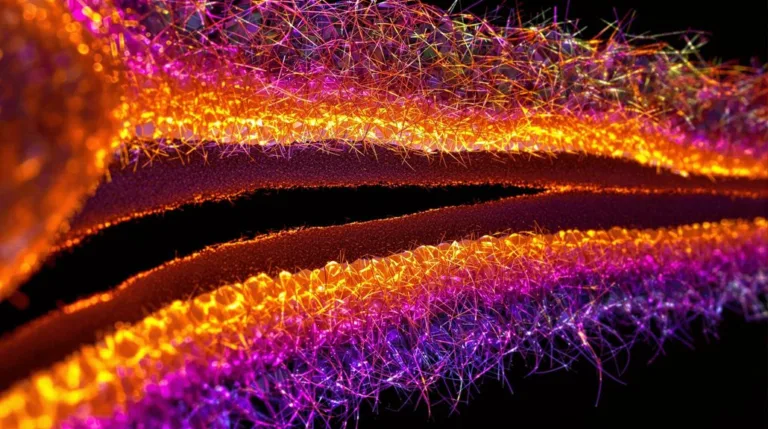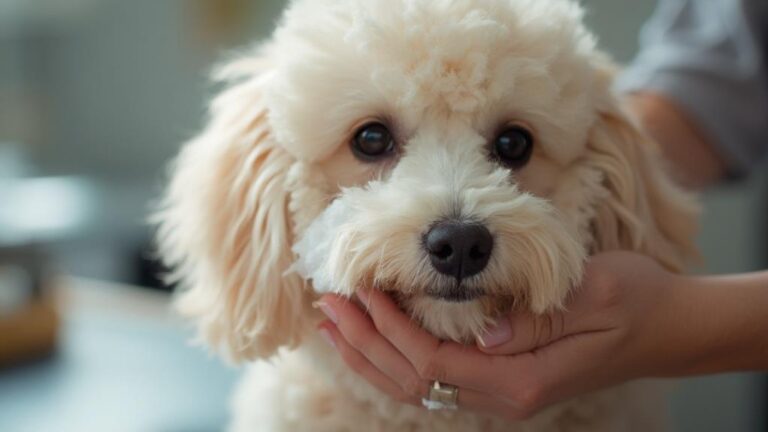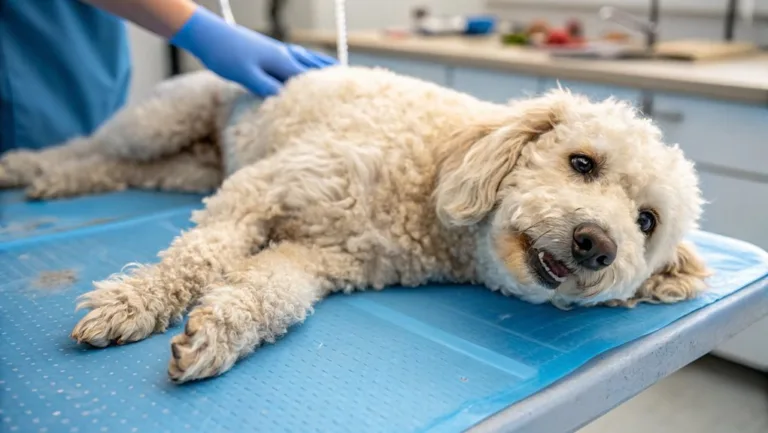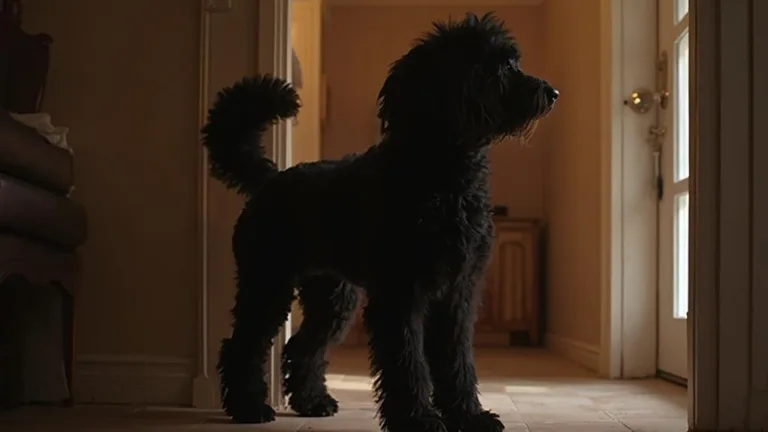Poodle Colors: A Comprehensive Guide To Each Unique Coat

There’s a variety of Poodle colors and styles, each with its unique look. Understanding the different color types is essential for anyone looking to become a Poodle pet owner.
This comprehensive guide will provide insight into the various poodle color variations by exploring the nuances of each breed’s coloring.
This article explains how poodle color varies by type, from solid-colored coats to more intricate patterns like sable or brindle.
Introduction To The Different Colors Of Poodle

Poodles are a beloved dog breed that comes in an array of colors, ranging from classic white to more exotic hues such as apricot or silver.
Each color is determined by specific genetic traits that pass through their lineage.
They are often guided by experienced poodle breeders who know which dominant coat color genes to select for breeding.
All shades of black, blue, gray, brown, cream, red, and white can be found among standard and miniature poodles alike.
White dogs have become increasingly popular due to their classic look and lively personalities in recent years.
As one might expect with any animal species, several factors must be considered when deciding on the right shade for your new pup.
Picking out the perfect puppy has never been easier with this comprehensive guide to each unique coat!
Apricot Poodle

Like a ray of sunshine, the apricot Poodle stands out in its coloring. The Apricot has a recessive gene that can be difficult to breed for.
The apricot poodle’s coat quickly fades when exposed to UV light. Elvis, my Poodle, also has this trait of being an apricot miniature. After being outside over the summer, he goes very light and almost blonde.
As per the breed standard, an ideal apricot Poodle should have black or dark brown eye rims and nose; however, a medium-brown color is accepted but not encouraged.
For those looking for a unique look on their four-legged friend, the apricot Poodle definitely delivers on this promise!
Black Poodle
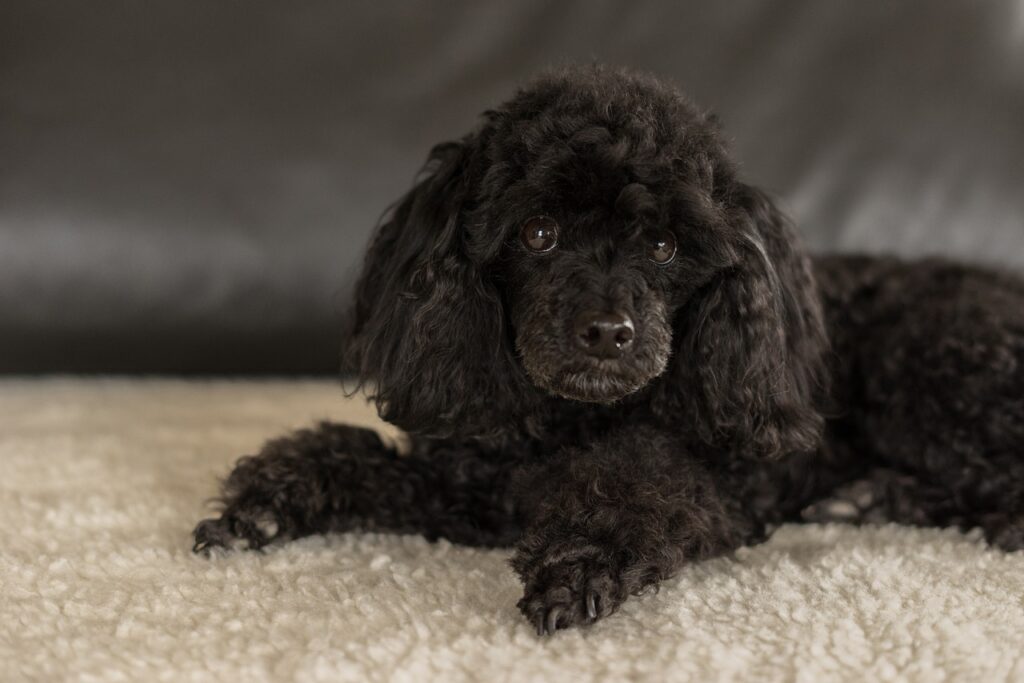
The distinctive black coat is one of the most sought-after solid colors. True black poodles are born black and do not change color, unlike other nonsolid poodle colors.
A black Poodle is an intense black, without any blue or silver tints in their outer fur. However, due to aging, some may experience graying on their outer coat and noticeability around the muzzle.
The skin on their face will also be a deep black when shaved. Unlike other colors, a true black Poodle won’t change as the puppy matures into an adult.
Blue Poodle
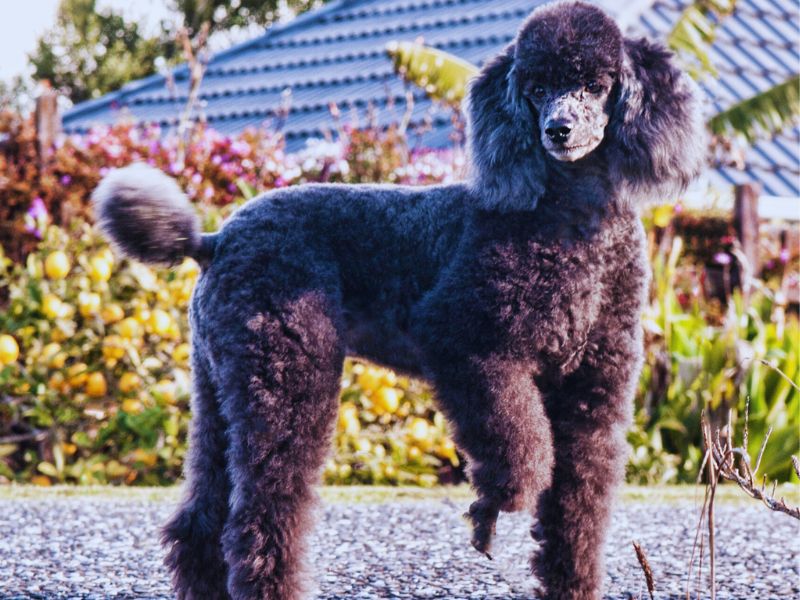
Blue Poodles range from light silver or blue to dark grey. These blue poodles are born with black fur, and as they grow older, the color begins to fade due to a gene called the progressive greying gene.
This process usually takes two years for blues and silvers. Due to their definitive breed color, the Blue Poodle puppy has become increasingly popular amongst poodle owners.
Interestingly, blue poodles are often mistaken for black when born and registered as the wrong color quite often.
As each dog is unique, some may have different intensities of color as they grow on various body parts.
Brown Poodle

Brown Poodles are a popular poodle coat color. Characteristics they should have deep, dark hues, liver points, and dark amber eyes to be considered pure brown.
Brown poodles are born brown and don’t change color like other Poodles by age two, so you know what you’re getting with these guys.
The lighter Café Au lait color has often been mistaken for brown but can easily be distinguished by its much lighter hues.
Beige Poodles also share similar characteristics with their darker counterparts, making them a great alternative choice for those looking for something different.
Cafe Au Lait Poodle

The Café au Lait Poodle has been included in the AKC breed standards for many years.
This particular color of the Poodle is characterized by its rich, well-saturated light brown color, similar to that of the French coffee of the same name.
As pups are birthed, the color of their fur can manifest fully within two years. They often begin with a deep brown coat as puppies.
Cafe au Lait Poodles combine shades of apricot, creamy, and chocolate tones, making them unique amongst all other colored poodles.
The range of colors and patterns makes it an exceptional choice amongst owners who appreciate a beautiful and distinguished-looking canine companion.
Cream Poodle

Cream Poodles are born with a light tan color. They can range from almost an apricot to nearly white.
Silver beige poodles are born when the cream gene is inherited from each parent, and as they age, the cream continues to lighten until around two years old, showing their true colors.
It’s important to remember that all dogs are individuals, so even within one litter, some puppies might be lighter than others or turn out differently regarding coat coloring after maturity.
Gray Poodle

Gray is among the many colors included in the breed standards for the toy, miniature and standard poodles.
This color has a white base coat with shades ranging from light ash blue to dark silver or asphalt gray.
The most desirable shade is a silvery-gray that produces a cold blue sheen without any brownish tint.
The Gray poodle breed can be born gray and stay gray, but they can also be born black and change gray over time.
Poodle coats of this color tend to be thinner and softer than those with other colors, although the hair at the bottom of the paws can fade and take on a brown hue.
Red Poodle

The red Poodle is impressive with its distinct vibrant coat color. It is important to note that the base of this color can vary from light apricot to deep and dark red tones.
It makes it difficult to distinguish between these two colors, red and apricot, especially as they age and reaches maturity.
Red Poodles are a rare and beautiful variation of the poodle breed due to the difficulty of successfully breeding the color.
They may be born with a deep or light red coat, which can change in intensity and hue over time due to age and light exposure.
Selective breeding is essential to maintain a pure red line of Poodles, but slight color changes can still occur.
Although much research still needs to be done to understand better how exactly these colors form, it is clear that they provide an interesting contrast compared to more traditional furry friends.
Silver Poodle

A silver Poodle can be born black, but around the two-years, they will ‘clear’ to a stunning silver hue.
You can tell if a Poodle is silver at six weeks of age when their face and paws will have some color change, and the rest of its coat gradually follows suit over the next year or two.
Silver Poodles have black points and dark brown eyes.
If you would like to know more about the Silver Standard Poodle, please Click Here
Silver Beige Poodle
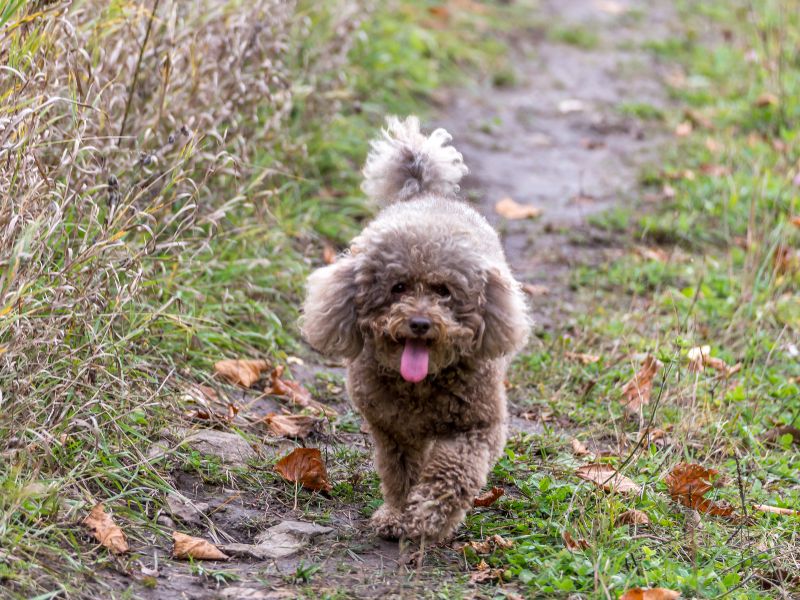
A Silver Beige Poodle is beautiful and comes in striking variations.
While they may appear similar to other poodle’s colors, their coat is much more muted in their shade and has a smokey look.
This color typically manifests itself over time, starting as a brown pup that gradually fades into a diluted brown hue as the dog matures.
Silver Beige Poodles are among many wonderful variations of different poodle colors, making them stand out.
White Poodle

Most Poodles that are white have a coat color that is pure and pristine, like freshly fallen snow. But, some breeders will classify a white with a bit of apricot and beige as a white poodle.
A small amount of black spotting is acceptable. However, the ticking gene should never be present. The ticking gene is totally different, making the coat look unclean and disheveled.
White Poodles are more prone to see dirt on their coat, so extra care for keeping them clean is essential.
Despite this added maintenance requirement, many owners opt for these dogs due to the distinctive beauty they bring to any household.
Phantom Poodle
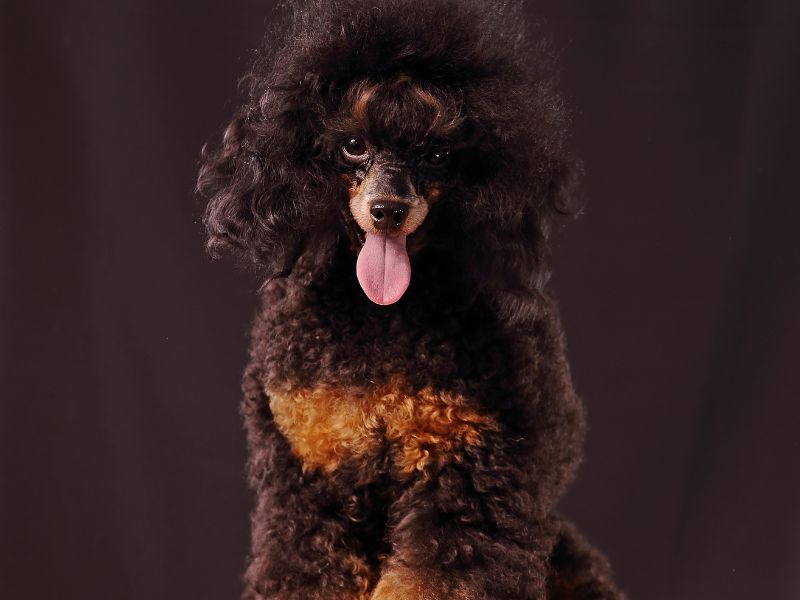
The world of Poodle coloration is truly fascinating, and Phantom Poodles are no exception.
These unique dogs have a solid base coat with corresponding points, usually the (ears, muzzle, and legs) that make them stand out.
Phantoms come in several colors: black & apricot, black & red, black & cream, black & gray, black & brown, or black & silver.
While some poodles may be born with these markings already visible on their coats, other times, they will only become defined as the puppy grows older – making for an exciting surprise for new owners!
For those who love variety and appreciate stunning contrasts in coloration, a Phantom Poodle could be a perfect choice!
Parti Poodle
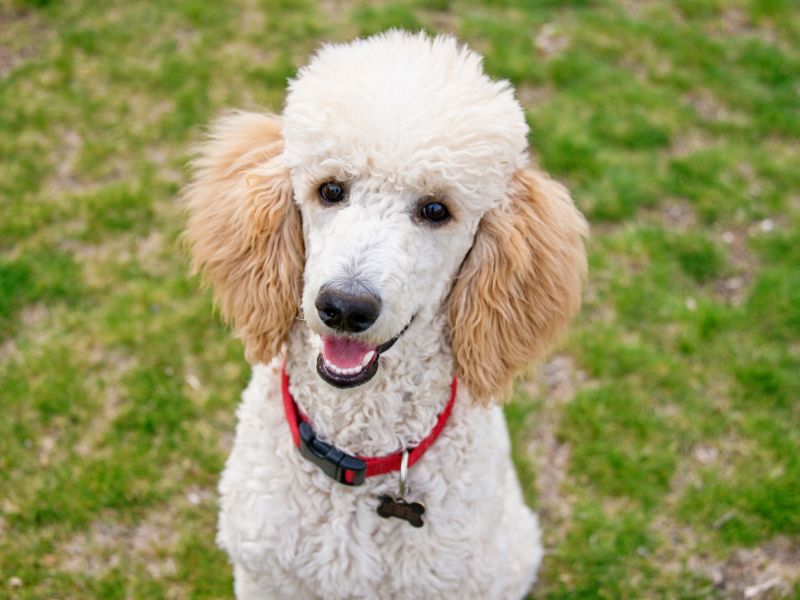
Parti Poodles are a unique mix of colors, such as white, brown, black, and other dark-colored poodles, but any mixture could be considered a parti poodle.
These dogs have at least a 50% white base coat; the secondary color can be anywhere on their body.
The white should be crisp and clear, while the second color should not fade into the white; these details become more apparent when the dog matures.
There is no guarantee what coat you’ll get when it comes to parti Poodles, making them all the more interesting to breeders and owners alike.
From black and white Poodles to white apricot, something new always awaits each litter!
Sable Poodle
The Sable Poodle is one of the most unusual and sought-after coat variations.
The signature feature of a sable poodle is the dark black tips on each strand of hair, giving them an overall gradient effect that transitions from base colors such as shades of red to black.
This color pattern has no specific or uniform distribution throughout their body and may even change over time in both puppies and adult dogs.
As recognized by AKC standards, sable poodles are highly desirable among the different types of coats available within this breed.
Brindle Poodle

Brindle is a coat pattern with black stripes layered over a lighter color, creating a tiger-striped appearance. The lighter background is often subdued, making it appear as though the coat is black with lighter stripes.
If you examine a single hair, you will see the shaft is the same color down, and the placement of these hairs in swirls produces the brindle pattern.
This pattern can be seen in various breeds, including Great Danes, Boxers, Bulldogs, and Poodles.
The stripes will still be visible even if the coat is shaved down to the skin. If the coat is kept short, the pattern will be more obvious, but if it is grown out, all the colors blend, giving the dog a more solid, muddy-looking appearance.
Merle Poodle

Merle Poodles have a gorgeous coat pattern that is rarely seen. Depending on the variety – blue merle, chocolate merle, red merle, or Phantom merle – the pattern shows patches of various colors that have been diluted from the original coat color for poodles.
The merle gene has the power to alter the color of your pup’s eyes, as well as the pigmentation of their nose and paws.
To sport this striking coat, a poodle must have one copy of the “M” Merle allele and one copy of the negative “m” Merle allele.
However, potential owners should know that Merle Poodles can sometimes result from poor breeding practices. As a result, they may be prone to ocular and auditory defects.
Some people may consider Merle Poodles to be real Poodles; however, the reality is that their genetics are not 100% Poodle.
Many people may think that Merle Poodles are genuine Poodles. However, the truth is that their genetics are not a perfect match.
It’s easy to see why they’re mistaken for Poodles – they may look the part, but their ancestry is quite different.
Merle Poodles may not be a pure breed, but their traits make them a breed of their own.
While not all Merle Poodles are produced through bad breeding, and not all will suffer from these health issues, there is still a higher risk than with a regular Poodle.
Harlequin Poodle

The Harlequin poodle is a distinctive and interesting breed of Poodle. These dogs typically have white coats with black spots or markings, usually in the form of two or three black points on their back (or mantle).
Other color combinations can also manifest with these dogs, such as brown and white or Gray and white.
When they are young, their coat may not be as distinct as they will be when they grow older. As adults, these poodles can typically have black points that contrast sharply against the white background of their fur.
The skin pigmentation must also follow this pattern – lighter where the fur is white and darker where there is black.
Further distinguishing features include dark brown eyes and nails that can either be black or white. All in all, the Harlequin Poodle stands out as one of the most beautiful breeds of dogs around.
Tuxedo Poodle
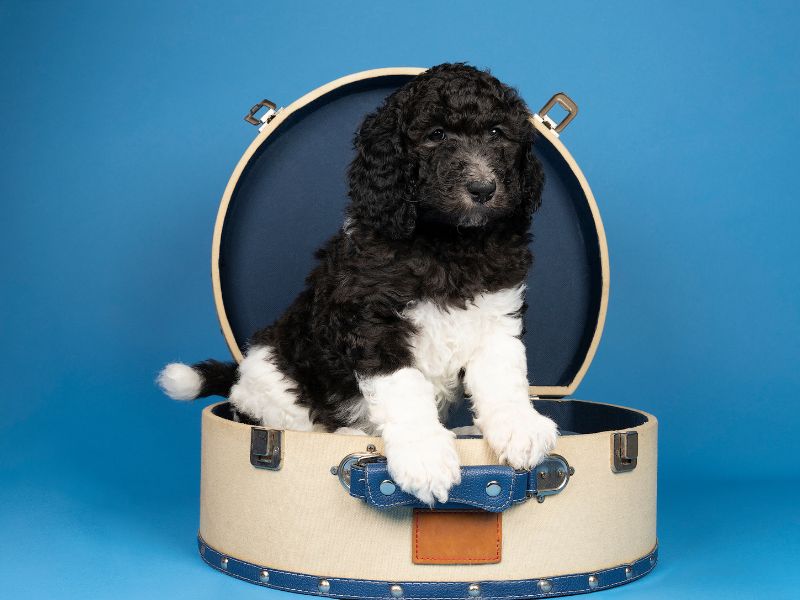
Tuxedo Poodles are a breed of dog that appears to be almost too sophisticated for their own good.
Their coats come in an array of cream, beige, black, red, and white colors; these blend in such a way that the end result is nothing short of stunning.
The traditional tuxedo look consists of a bib-like marking on the chest which may or may not wrap around the neck, with a white belly connected to it at the bottom.
Finally, there’s typically a darker color covering the saddle (back) – most commonly black – although rarer versions featuring blue or red also exist.
Those who have ever seen one can attest that this unique combination creates an unforgettable sight indeed!
Tri-Color Poodle

Tricolored poodles feature two distinct color patterns and then a subtle third. The most common colors for tricolored poodles include black, blue, red, silver, or white.
Tri-Color Poodles, often known as Parti Poodles, boast a stunning coat pattern of three colors. Usually, these colors will be a white or black base color with patches of two others.
Not only do they make an attractive pet, but they also draw attention wherever they go. However, they may not be eligible to enter dog shows because of their color combinations.
Which Poodles Change Color When They Get Older
Poodles of many colors can clear and change to different shades as they age.
- Beige Poodles, for example, are often born a darker shade that lightens over time.
- Black Poodles may appear black at birth but turn blue when they age two.
- Red Poodles typically start with a deep red coloration before becoming lighter in hue.
- White Poodles begin their lives dark gray or slate-colored and gradually become creamier in tone.
Light poodle colors such as apricot and silver can also be affected by the clearing process, usually taking on a much lighter shade than when they were first born.
What Are The Most Common Colors Of Poodle
Poodles come in various colors: black, red, white, and silver. The most common poodle color is black, followed by chocolate and white.
Other popular colors include reds that range from light apricot to deep mahogany; silvers ranging from pale blue-gray to slate gray; whites varying from off-white to bright ivory; and browns from cafe au lait to dark liver.
All these colors make the Poodle an attractive breed for any family.
Why Are There So Many Different Poodle Colors
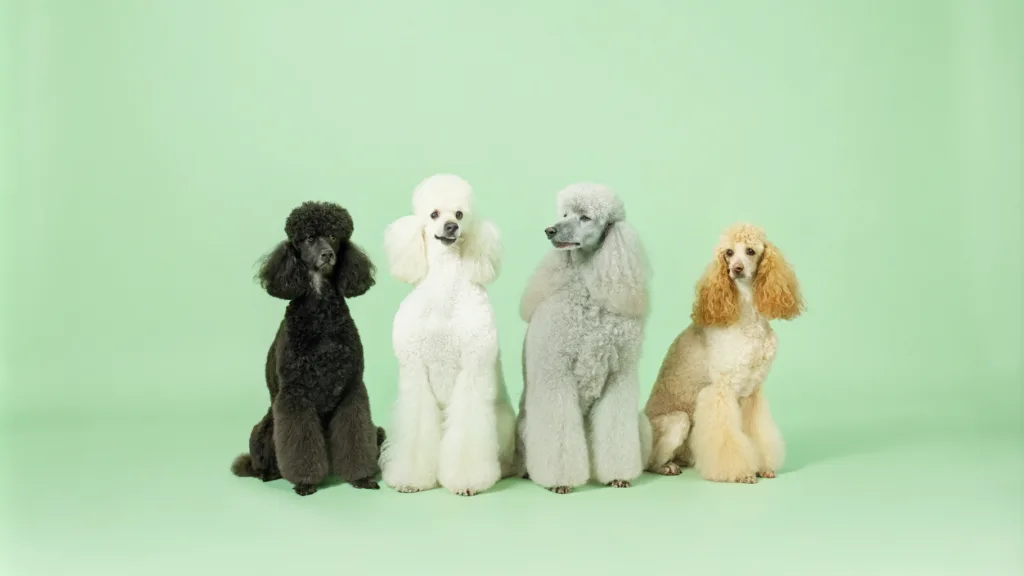
One of the most remarkable and often overlooked aspects of poodles is their incredible range of colors.
The wide range of coat colors in Poodles is due to the complexity of their genetics. A variety of gene combinations can result in a plethora of hues, and the intentional breeding of certain colors further enhances this through careful selection.
Poodles come in a huge variety of coat colors, and selective breeding plays a significant role in this. Breeders will often intentionally mate poodles with specific coat colors to achieve the desired outcome for the litter.
This can expand the breed’s color options as breeders strive to create poodles with unique and desirable coat colors.
Whether you’re looking for a traditional white poodle or something more exotic, like an apricot version, there’s no shortage of options.
Is There A Rare Poodle Coat Color

Poodles come in various colors, with black and white being the most common. Red poodles are uncommon, but some blue and silver are much rarer.
Apricot is considered to be the rarest color among poodle coats, caused by a recessive gene that produces a very light red or cream shade.
This shade is hypothesized to have been the last one developed amongst this breed due to its genetic history.
As such, it can prove difficult to find an apricot-colored poodle as compared to other shades.
How to maintain the colors of the Poodle and reduce color change or loss?
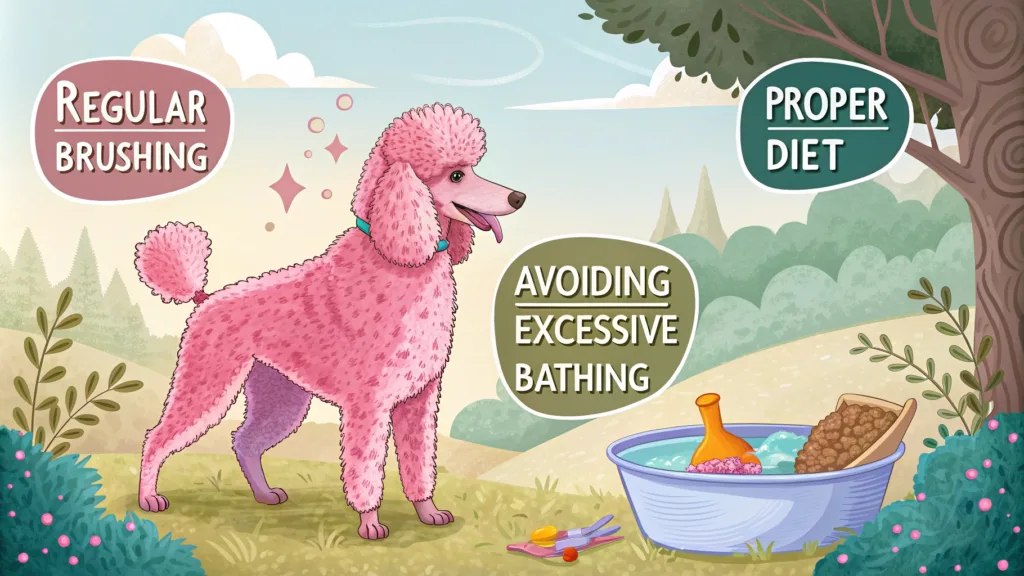
| Shampoos | One way to maintain the colors of your Poodle is by using high-quality shampoos and conditioners specifically designed for dogs with colored coats. These products will help lock in the color and prevent fading over time. It’s also important to avoid harsh chemicals that can strip away natural oils from your pet’s coat, causing it to lose its luster. |
| Keep out of the sun | Another helpful tip is to keep your standard, miniature, and toy poodle out of direct sunlight for extended periods. The sun can cause your pet’s coat to fade. |
| Grooming | No matter what type of Poodle you have, proper grooming is necessary to keep the poodle coat shiny and healthy. |
| Diet | It is important to watch your pet’s diet and ensure he receives the proper nutrition. This will help his coat stay healthy and keep its color. |
Conclusion
Poodles are an intriguing breed with many coat colors ranging from classic white to rarer apricot.
Thanks to their unique genetic makeup and the expertise of experienced breeders, Poodles can have colors such as apricot, silver, cream, gray, and red.
Even though some colors might be harder to breed due to their recessive genes or rarity, the AKC breed standard provides guidance for the ideal colors.
It’s essential to remember that each Poodle is one of a kind and can have natural variations in their coat color, even within the same litter.
Additionally, their coat color may alter as they age or when exposed to different environments, such as sunlight.
Whether you prefer the classic white Poodle or a more unique color, Poodles are renowned for their intelligence, adaptability, and vivacious personalities.
If you plan to bring a Poodle into your family, working with a reliable breeder familiar with the nuances of coat colors and genetics is essential.
They can help you pick a Poodle with the color that fits your preferences. If you want to show your dog in a competition, only 11 poodle colors are recognized by AKC.
These include Apricot, Black, Blue, Brown, Cream, Red, Silver, Silver Beige, White, Cafe Au Lait, and Gray. So please bear this in mind before buying a puppy.
With the right care and attention, your Poodle’s coat color will remain an eye-catching and stunning feature throughout their lifetime.
FAQ: Poodle Colors
The standard colors recognized by major kennel clubs typically include black, white, brown, gray, apricot, red, and cream.
However, it’s important to note that many different colors and color combinations exist in poodles.
Some less common but still recognized colors include silver, silver beige, and café au lait.
The American Kennel Club (AKC) recognizes these colors along with patterns like parti-color, phantom, and sable.
Each color has its unique charm, and poodles can display a wide range of shades within these color categories.
Poodles inherit their coat color through a complex genetic process. Each poodle receives a color gene from each parent, which determines their final coat color.
Some colors are dominant, while others are recessive coat colors. For example, black is typically dominant over brown.
This means that if a poodle inherits a black gene from one parent and a brown gene from the other, it will likely appear black.
However, if both parents pass on a brown gene, the poodle will be brown. The interaction of various genes can also lead to the wide variety of shades and patterns seen in poodles.
Apricot and cream poodles can sometimes be difficult to distinguish because the apricot color can vary greatly in intensity. Some apricot poodles are so light that they may indeed appear to be cream.
This is due to genetic factors and the expression of color genes. Additionally, apricot poodles may fade as they age, further blurring the line between apricot and cream.
The intensity of the apricot color can range from a deep, rich shade to a very pale, almost cream-like hue. Experienced breeders and judges can usually differentiate between the two colors, but to the untrained eye, they may look very similar.
| Resource Url | |
| www.akc.com | breed standards |
| vcahospitals.com | canine genetics |

